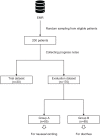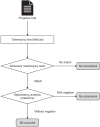Using Natural Language Processing Techniques to Detect Adverse Events From Progress Notes Due to Chemotherapy
- PMID: 35342285
- PMCID: PMC8943584
- DOI: 10.1177/11769351221085064
Using Natural Language Processing Techniques to Detect Adverse Events From Progress Notes Due to Chemotherapy
Abstract
Objective: In recent years, natural language processing (NLP) techniques have progressed, and their application in the medical field has been tested. However, the use of NLP to detect symptoms from medical progress notes written in Japanese, remains limited. We aimed to detect 2 gastrointestinal symptoms that interfere with the continuation of chemotherapy-nausea/vomiting and diarrhea-from progress notes using NLP, and then to analyze factors affecting NLP.
Materials and methods: In this study, 200 patients were randomly selected from 5277 patients who received intravenous injections of cytotoxic anticancer drugs at Kagawa University Hospital, Japan, between January 2011 and December 2018. We aimed to detect the first occurrence of nausea/vomiting (Group A) and diarrhea (Group B) using NLP. The NLP performance was evaluated by the concordance with a review of the physicians' progress notes used as the gold standard.
Results: Both groups showed high concordance: 83.5% (95% confidence interval [CI] 74.1-90.1) in Group A and 97.7% (95% CI 91.3-99.9) in Group B. However, the concordance was significantly better in Group B (P = .0027). There were significantly more misdetection cases in Group A than in Group B (15.3% in Group A; 1.2% in Group B, P = .0012) due to negative findings or past history.
Conclusion: We detected occurrences of nausea/vomiting and diarrhea accurately using NLP. However, there were more misdetection cases in Group A due to negative findings or past history, which may have been influenced by the physicians' more frequent documentation of nausea/vomiting.
Keywords: Natural language processing; data mining; drug therapy; drug-related side effects and adverse reactions; electronic health records; pharmacovigilance; progress notes.
© The Author(s) 2022.
Conflict of interest statement
Declaration of conflicting interests: The author(s) declare the following potential conflicts of interest with respect to the research, authorship and publication of this article: M.T. was an employee of Daiichi Sankyo Co., Ltd. before this study and owns shares in Daiichi Sankyo Co., Ltd. H.Y. was paid advisory fees by Daiichi Sankyo Co., Ltd. M.T. and H.Y.’s interests were reviewed and are managed by Kagawa University in accordance with their conflict-of-interest policies. T.T., A.H., and H.T. are employees of Daiichi Sankyo Co., Ltd. All other authors declare no competing interests.
Figures



Similar articles
-
Automated System to Capture Patient Symptoms From Multitype Japanese Clinical Texts: Retrospective Study.JMIR Med Inform. 2024 Sep 24;12:e58977. doi: 10.2196/58977. JMIR Med Inform. 2024. PMID: 39316418 Free PMC article.
-
Natural Language Processing of Clinical Notes to Identify Mental Illness and Substance Use Among People Living with HIV: Retrospective Cohort Study.JMIR Med Inform. 2021 Mar 10;9(3):e23456. doi: 10.2196/23456. JMIR Med Inform. 2021. PMID: 33688848 Free PMC article.
-
Moving Biosurveillance Beyond Coded Data Using AI for Symptom Detection From Physician Notes: Retrospective Cohort Study.J Med Internet Res. 2024 Apr 4;26:e53367. doi: 10.2196/53367. J Med Internet Res. 2024. PMID: 38573752 Free PMC article.
-
Overview of the First Natural Language Processing Challenge for Extracting Medication, Indication, and Adverse Drug Events from Electronic Health Record Notes (MADE 1.0).Drug Saf. 2019 Jan;42(1):99-111. doi: 10.1007/s40264-018-0762-z. Drug Saf. 2019. PMID: 30649735 Free PMC article. Review.
-
Natural language processing of symptoms documented in free-text narratives of electronic health records: a systematic review.J Am Med Inform Assoc. 2019 Apr 1;26(4):364-379. doi: 10.1093/jamia/ocy173. J Am Med Inform Assoc. 2019. PMID: 30726935 Free PMC article.
Cited by
-
Contribution of Synthetic Data Generation towards an Improved Patient Stratification in Palliative Care.J Pers Med. 2022 Aug 4;12(8):1278. doi: 10.3390/jpm12081278. J Pers Med. 2022. PMID: 36013227 Free PMC article. Review.
-
Is artificial intelligence capable of generating hospital discharge summaries from inpatient records?PLOS Digit Health. 2022 Dec 12;1(12):e0000158. doi: 10.1371/journal.pdig.0000158. eCollection 2022 Dec. PLOS Digit Health. 2022. PMID: 36812600 Free PMC article.
-
Year 2022 in Medical Natural Language Processing: Availability of Language Models as a Step in the Democratization of NLP in the Biomedical Area.Yearb Med Inform. 2023 Aug;32(1):244-252. doi: 10.1055/s-0043-1768752. Epub 2023 Dec 26. Yearb Med Inform. 2023. PMID: 38147866 Free PMC article.
-
Improving Clinical Documentation with Artificial Intelligence: A Systematic Review.Perspect Health Inf Manag. 2024 Jun 1;21(2):1d. eCollection 2024 Summer. Perspect Health Inf Manag. 2024. PMID: 40134899 Free PMC article.
-
Development of a novel drug information provision system for Kampo medicine using natural language processing technology.BMC Med Inform Decis Mak. 2023 Jul 13;23(1):119. doi: 10.1186/s12911-023-02230-3. BMC Med Inform Decis Mak. 2023. PMID: 37442993 Free PMC article.
References
-
- Lindley C, Vasa S, Sawyer WT, Winer EP. Quality of life and preferences for treatment following systemic adjuvant therapy for early-stage breast cancer. J Clin Oncol. 1998;16:1380-1387. - PubMed
-
- Coates A, Abraham S, Kaye SB, et al.. On the receiving end—patient perception of the side-effects of cancer chemotherapy. Eur J Cancer Clin Oncol. 1983;19:203-208. - PubMed
-
- Hesketh PJ. Chemotherapy-induced nausea and vomiting. N Engl J Med. 2008;358:2482-2494. - PubMed
-
- Bossi P, Airoldi M, Aloe Spiriti MA, et al.. A multidisciplinary expert opinion on CINV and RINV, unmet needs and practical real-life approaches. Expert Opin Drug Saf. 2020;19:187-204. - PubMed
-
- Gupta K, Walton R, Kataria SP. Chemotherapy-induced nausea and vomiting: pathogenesis, recommendations, and new trends. Cancer Treat Res Commun. 2021;26:100278. - PubMed
LinkOut - more resources
Full Text Sources
Miscellaneous

